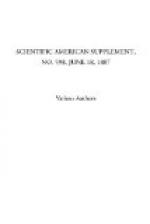Notwithstanding these differences, which at first may appear very great, a careful study of the best styles—those that achieved the greatest and most lasting popularity—will reveal the fact that they are all based upon certain fundamental laws and principles, and that all are good, bad, or indifferent according as they conform to or violate these principles. These essentials having been preserved, the opportunities for the exercise of individual or national taste are almost boundless.
II. Position of Ornament.—The position that ornament occupies is necessarily a secondary one, as it cannot exist independently, but is always applied to objects created for some purpose entirely independent of their capacity for pleasing. This gives us one of the great underlying principles that should characterize all ornament, viz., it must be subordinate to the object which it adorns, and must not detract from its use. We often see this rule violated in personal, household, and architectural decoration—windows so overloaded with projecting cornices and lattice work as to almost exclude light and air; knife handles carved so elaborately that it is impossible to grasp them firmly; styles of dress in form or color that impede the motions of the wearer, and make the clothes, rather than the personality of the wearer, the most noticeable feature. From this principle there is but a step to another: All ornament should be modest and moderate. It must not obtrude itself, and a great profusion and ostentation in its application is always a sign of degeneracy and bad taste. Of course some objects, from their nature, position, and use, will admit of greater and more elaborate ornament than others.
Ornament, being entirely subordinate, should not conceal the construction of the object. In architecture it should follow the leading lines of the building, and should emphasize, or at least suggest, the construction. If architectural in character, it should so enter into the construction of the building that it could not be taken away without injuring it.
We must feel that a column, no matter how beautiful, is supporting something. A floor, always a plane surface, must not be tiled or decorated in any way to express relief. This would apparently destroy the essential constructive quality of a floor, viz., flatness. For the same reason, all shams, such as painted arches, pillars, etc., are not legitimate. As long as they do not actually exist, they are evidently not necessary to the construction, and have no purpose save an imaginary decorative one, and in the words of Owen Jones, construction must be decorated—not decoration constructed.
III. Scope of Ornament.—The scope of ornamental art is almost boundless. It is applied to objects large and small, adapted to the most various uses, constructed of the most different materials. As the ornamentation is always to be subordinate to the object, considerations regarding size, use, position, material, etc., must govern it. An ornament that would be admirable applied to one object, might be detestable if applied to another. A design cannot be made without reference to its future application.




